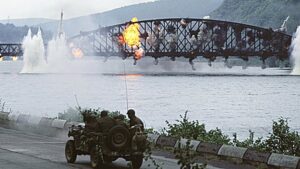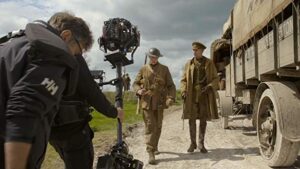Plotting arc

Sam Mendes’ World War I film 1917 (Universal, 2019) earned Academy Awards for Best Cinematography, Best Visual Effects, and Best Sound Mixing.
Director Sam Mendes’ World War 1 film 1917 (Universal, 2019) is a remarkable cinematic achievement that was acknowledged at this year’s Academy Awards. The picture earned three Oscars in February 2020: Best Cinematography, Best Visual Effects, and Best Sound Mixing.
The brutal standoff between Allied and Central powers during the early part of World War I serves to illustrate the horrors of trench warfare. The movie delivers on that definitive optic. The remnants of the trench-attrition strategy frame the initial scenes in Mendes’ storyline in strikingly innovative structural ways. Cinematographer Roger Deakins uses his camera to create a flow of action that seemingly occurs in one long take.
The sustaining continuity imbues 1917 with a charged intensity. The protagonists — two young British corporals — embark on a mission to alert a frontline battalion, the Second Devons, of a deadly ambush. The younger corporal, Blake (Dean-Charles Chapman), is especially keen on accepting the mission because his elder brother, Joseph (Richard Madden), is an officer in the frontline battalion.
Charged to beat the clock, the corporals rush through long, backline trenches and into expansive, open battlefields, largely abandoned by the Germans who have since pulled back from the Western Front. The no-man’s land is patrolled by German and Allied aircraft and by an occasional German sniper hiding amid the ruins. It’s here in the open battlefields that 1917’s visual- and sound-effects artists take over the action with an unending barrage of ground explosives and aerial artillery.
Using actual explosive devices, the crew filmed on location at the English Plains of Salisbury. As the plot progresses, the older Lance Corporal Schofield (George MacKay) must dodge sniper fire as he crosses a decimated bridge. The hazardous path is narrower than a GI’s boot, jig-jagging metal beams strewn about like pick up sticks. I found this heart-throbbing feat to be a perfect plotting arc leading to 1917’s conclusion.
Filmmaker Mendes says he was inspired by World War I stories his grandfather told. Watching 1917 reminded me of other great war films that rely on a bridge as a key plotting element and source of thematics.
Division initiative

The Bridge at Remagen (United Artists, 1969) is often overlooked in discussions about World War II films.
The Bridge at Remagen (United Artists, 1969) is often overlooked in discussions about World War II films. The historical war drama was based on Ken Hechler’s 1957 nonfiction book The Bridge at Remagen: The Amazing Story of March 7, 1945, the Day the Rhine River Was Crossed. The authorship of the book by Hechler and his own personal history offer compelling backstories, which I’ll get to later.
The “amazing story of March 7” in the book’s subtitle cites the day in 1945 when the Allies’ 9th Armored Division advanced toward Remagen — a small German town of 5000 — and discovered that the Ludendorff Bridge over the Rhine remained surprisingly intact. The Germans had constructed the iron bridge during World War I to move troops to the Western Front and create access to logistical support. Hastily on March 7, the 9th Armored Unit captured the Ludendorff Bridge. The Germans attempted to destroy it and deny the Allies passage into the country. Some Allied units were able to cross the bridge before it collapsed into the Rhine, however. The establishment of a military foothold at Remagen helped hasten the war’s end.
The 1969 film portrays the weeklong battle at the Ludendorff Bridge against a backdrop of special effects artillery that foreshadowed the array of explosives seen in Mendes’ 1917. Director John Guillerman filmed in Czechoslovakia with a large cast whose character names were altered from Hechler’s book. The author had been with the 9th Armored Division at Remagen. He interviewed fellow soldiers — on both sides — after the war.
Later, Hechler would become a prominent American statesman, serving first as a special assistant to both FDR and Harry Truman. In 1958, he used proceeds from his book sales and movie rights to launch a political career. He represented West Virginia’s 4th District in Congress for nine terms (1959-77) after which he served as Virginia’s attorney general from 1985-2001.
Hechler lived to be 102 years old (1914-2016 ). People often asked him about the accuracy of the film version of his story. In one interview, he said the movie was about 95 percent accurate and added, “I was very happy because it brought attention to the initiatives and training of American soldiers. They took advantage of an opportunity that had not been planned at all.” (Charleston Gazette, May 19, 2005.)
Irony and symbolism

The Bridge on the River Kwai (Columbia Pictures, 1957) is arguably one of the greatest World War II pictures of all time.
The roles of heroics and war initiative on display in 1917 and The Bridge at Remagen are less obvious and more symbolic in The Bridge on the River Kwai (Columbia Pictures, 1957). This is arguably one of the greatest World War II pictures of all time. Directed by David Lean, action takes place in a Japanese prisoner-of-war camp in Burma. Lt. Colonel Nicholson (Alec Guinness) marches his British men into the POW camp whistling the tune “The Colonel Bogey March.” Japanese commander Colonel Saito (Sessue Hayakawa) is an insecure officer, which doesn’t bode well for the Brits. Saito demands that all the POWS, including officers, construct a railroad bridge over the nearby river. Nicholson refuses and is forced to sit in an iron box in the direct sun alongside other dissenting officers.
Eventually, Nicholson realizes the half-hearted laborers intend to sabotage the bridge. He charges his men to build a bridge worthy of British integrity. Inspired by Pierre Boulle’s 1952 French novel The Bridge Over the River Kwai, Lean’s film crackles with pointed irony, thanks to screenwriters Michael Wilson and Carol Foreman. The novel had taken a more sardonic, mocking approach toward the Japanese soldiers and English POWs, especially in the depiction of Nicholson. He’s drawn as a haughty and prideful British officer who ensures the bridge is constructed perfectly, buoying the morale of his soldiers. His determination, ironically, is a gift to the Japanese, even as the Allies are plotting to destroy the completed bridge.
The Bridge on the River Kwai poses complex interpretive issues about the vagaries of war and military behavior as conveyed by the Japanese soldiers, Commander Saito, Lt. Col. Nicholson, and the British captives. Roger Ebert focused on the symbolism of the bridge in this 1999 description: “[The war] narrows down to a single task, building a bridge across the Kwai. The Bridge on the River Kwai is one of the few [war movies] that focuses not on large rights or wrongs but on individuals. Like Robert Graves’ 1929 World War I memoir, Good-Bye to All That, it shows men grimly hanging on to military discipline and pride in their units as a way of clinging to sanity. By the end of Kwai, they are less interested in who wins than in how individual characters behave.” (Great Movies, April 18, 1999)Cold War maneuvers

The real-life bridge in Steven Spielberg’s Bridge of Spies (Walt Disney Studios, 2015) is divided in half.
The real-life bridge in Steven Spielberg’s Bridge of Spies (Walt Disney Studios, 2015) is divided in half. With a borderline at its center, one half of the bridge connects to West Berlin’s Wannsee District; the other half enters East Germany. The iron bridge was inaugurated in 1907 and named the Glienicke to commemorate its relationship to the nearby historic Schloss Glienicke Palace.
Positioned over the Havel River between Berlin and Potsdam, the bridge served as a central checkpoint during the Cold War, taking on additional significance after the hastily constructed Berlin Wall in 1961. The Glienicke was uniquely controlled by the Soviet army in East Germany; all other Cold War checkpoints were controlled by the German Democratic Republic (GDR). It was a popular destination for swaps of intelligence prisoners between East and West, earning the nickname “the bridge of spies.”
The first prisoner swap took place at dawn on Feb. 10, 1962, when the Americans released Rudolf Abel, a Soviet spy convicted in New York in 1957. He was sentenced to 30 years in the Atlanta Federal Penitentiary. Abel was born Robert August Fisher to British emigres — he had several fake identities in his work as a KGB operative. Matt Charman’s 2010 book Bridge of Spies: A True Story of the Cold War revolves around the Abel prisoner exchange, and the author adapted the story into a screenplay with Joel and Ethan Coen.
Being a Steven Spielberg film, Bridge of Spies can be viewed as a Cold War suspense drama with underlying themes that intimate individual and national integrity. James Donovan (Tom Hanks), an insurance lawyer, defends Abel at his trial. At the end of the trial, Donovan argues against the death penalty, which had been used in 1953 against the accused spies Julius and Ethel Rosenberg. Donovan viewed a death sentence as a political risk that could lead to future retribution by the Soviet Union and other Cold War adversaries. In 1961, the CIA recruited Donovan to negotiate a spy exchange between Abel and Gary Francis Powers, an American U-2 spy pilot held captive in the Soviet Union. His plane had been shot down in 1960. Donovan first visits Abel (Mark Rylance) at the Atlanta Penitentiary in 1961 where he finds the prisoner enjoying his leisure time as an amateur painter. Then he flies to Berlin for a strategic meeting with the GDR attorney general seeking approval of the swap. In a tense back-and-forth, the AG agrees to the swap but with the exchange of an American graduate student in captivity for trying to escape over the Berlin Wall. Donovan refuses, saying it’s both or none. The AG relents.
In 1961, the CIA recruited Donovan to negotiate a spy exchange between Abel and Gary Francis Powers, an American U-2 spy pilot held captive in the Soviet Union. His plane had been shot down in 1960. Donovan first visits Abel (Mark Rylance) at the Atlanta Penitentiary in 1961 where he finds the prisoner enjoying his leisure time as an amateur painter. Then he flies to Berlin for a strategic meeting with the GDR attorney general seeking approval of the swap. In a tense back-and-forth, the AG agrees to the swap but with the exchange of an American graduate student in captivity for trying to escape over the Berlin Wall. Donovan refuses, saying it’s both or none. The AG relents.
Bridge of Spies is rich in period production values and directorial touches. A blue noir tints the incessant rain. We feel Donovan’s discomfort in his unheated and damp accommodations; an agonizing cough and head cold complicate his mission.
Spielberg stages the final climactic scene with blurry figures shrouded in opaque mist. Abel refuses to advance toward the checkpoint. The American student doesn’t show. Therein lies Bridge of Spies’ final moments of suspense.
As in many of Spielberg’s history-based films, the script avoids harsh cynicism. Instead, it elevates character determination and integrity, though some take issue with its apparent poetic license.
There are other war films with bridges in their storytelling: The Bridges at Toko-Ri (Paramount Pictures, 1954) and A Bridge Too Far (United Artists, 1977) among others. I especially like the variety and substance of the four discussed above.




